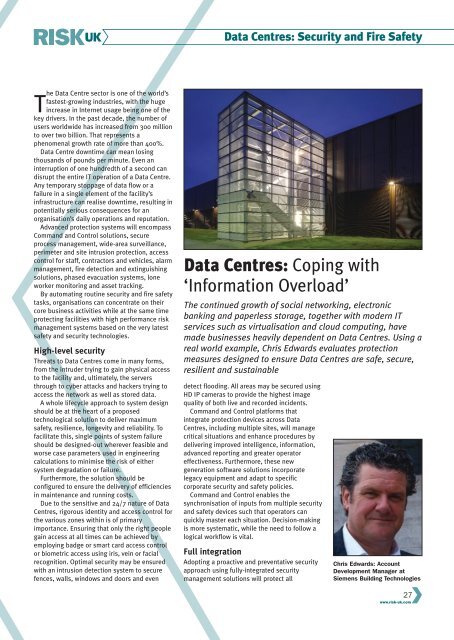RiskUKOctober2017
Create successful ePaper yourself
Turn your PDF publications into a flip-book with our unique Google optimized e-Paper software.
Data Centres: Security and Fire Safety<br />
The Data Centre sector is one of the world’s<br />
fastest-growing industries, with the huge<br />
increase in Internet usage being one of the<br />
key drivers. In the past decade, the number of<br />
users worldwide has increased from 300 million<br />
to over two billion. That represents a<br />
phenomenal growth rate of more than 400%.<br />
Data Centre downtime can mean losing<br />
thousands of pounds per minute. Even an<br />
interruption of one hundredth of a second can<br />
disrupt the entire IT operation of a Data Centre.<br />
Any temporary stoppage of data flow or a<br />
failure in a single element of the facility’s<br />
infrastructure can realise downtime, resulting in<br />
potentially serious consequences for an<br />
organisation’s daily operations and reputation.<br />
Advanced protection systems will encompass<br />
Command and Control solutions, secure<br />
process management, wide-area surveillance,<br />
perimeter and site intrusion protection, access<br />
control for staff, contractors and vehicles, alarm<br />
management, fire detection and extinguishing<br />
solutions, phased evacuation systems, lone<br />
worker monitoring and asset tracking.<br />
By automating routine security and fire safety<br />
tasks, organisations can concentrate on their<br />
core business activities while at the same time<br />
protecting facilities with high performance risk<br />
management systems based on the very latest<br />
safety and security technologies.<br />
High-level security<br />
Threats to Data Centres come in many forms,<br />
from the intruder trying to gain physical access<br />
to the facility and, ultimately, the servers<br />
through to cyber attacks and hackers trying to<br />
access the network as well as stored data.<br />
A whole lifecycle approach to system design<br />
should be at the heart of a proposed<br />
technological solution to deliver maximum<br />
safety, resilience, longevity and reliability. To<br />
facilitate this, single points of system failure<br />
should be designed-out wherever feasible and<br />
worse case parameters used in engineering<br />
calculations to minimise the risk of either<br />
system degradation or failure.<br />
Furthermore, the solution should be<br />
configured to ensure the delivery of efficiencies<br />
in maintenance and running costs.<br />
Due to the sensitive and 24/7 nature of Data<br />
Centres, rigorous identity and access control for<br />
the various zones within is of primary<br />
importance. Ensuring that only the right people<br />
gain access at all times can be achieved by<br />
employing badge or smart card access control<br />
or biometric access using iris, vein or facial<br />
recognition. Optimal security may be ensured<br />
with an intrusion detection system to secure<br />
fences, walls, windows and doors and even<br />
Data Centres: Coping with<br />
‘Information Overload’<br />
The continued growth of social networking, electronic<br />
banking and paperless storage, together with modern IT<br />
services such as virtualisation and cloud computing, have<br />
made businesses heavily dependent on Data Centres. Using a<br />
real world example, Chris Edwards evaluates protection<br />
measures designed to ensure Data Centres are safe, secure,<br />
resilient and sustainable<br />
detect flooding. All areas may be secured using<br />
HD IP cameras to provide the highest image<br />
quality of both live and recorded incidents.<br />
Command and Control platforms that<br />
integrate protection devices across Data<br />
Centres, including multiple sites, will manage<br />
critical situations and enhance procedures by<br />
delivering improved intelligence, information,<br />
advanced reporting and greater operator<br />
effectiveness. Furthermore, these new<br />
generation software solutions incorporate<br />
legacy equipment and adapt to specific<br />
corporate security and safety policies.<br />
Command and Control enables the<br />
synchronisation of inputs from multiple security<br />
and safety devices such that operators can<br />
quickly master each situation. Decision-making<br />
is more systematic, while the need to follow a<br />
logical workflow is vital.<br />
Full integration<br />
Adopting a proactive and preventative security<br />
approach using fully-integrated security<br />
management solutions will protect all<br />
Chris Edwards: Account<br />
Development Manager at<br />
Siemens Building Technologies<br />
27<br />
www.risk-uk.com

















